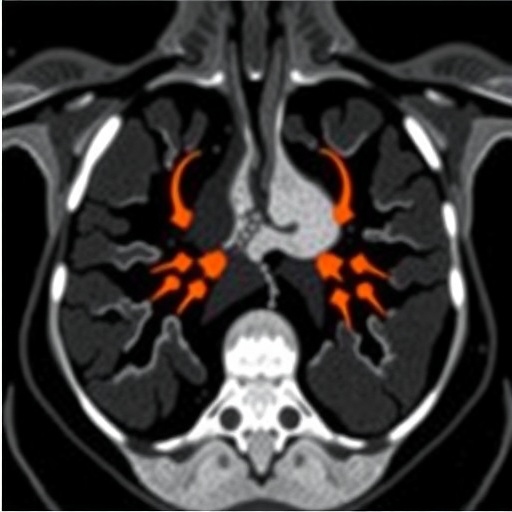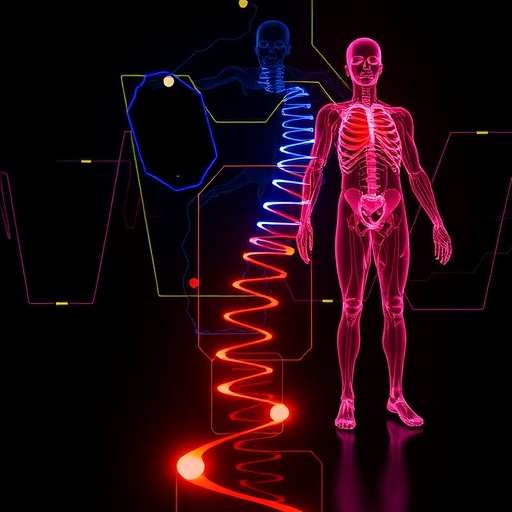In a groundbreaking study that promises to revolutionize our understanding of age-related thymic involution, researchers have developed an innovative automated quantitative evaluation method using plain chest CT scans. This research, conducted by a team of experts led by Y.T. Okamura, sheds light on the complex changes that occur in the thymus gland as individuals age, and its implications for immune system function. The thymus, a crucial organ for T cell development, undergoes significant involution with aging, which can impact immunity and increase susceptibility to infections and diseases.
Traditionally, the assessment of thymic involution has relied heavily on subjective interpretation by radiologists analyzing CT images. This method has its limitations, including variability among practitioners and potential for misdiagnosis. However, the novel approach introduced in this study utilizes advanced algorithms and artificial intelligence to automate the evaluation process, providing consistent and reliable results. By minimizing human error, this method enables a more precise analysis of the thymus gland’s condition throughout the aging process.
The researchers employed a robust dataset comprising chest CT scans from diverse age groups, allowing them to systematically analyze the changes in thymic tissue volume over time. Utilizing machine learning techniques, the team trained their algorithms to recognize thymic structures and quantify their size and density accurately. This quantitative data can play a pivotal role in understanding the dynamics of the thymus gland and its decline with age.
One of the main findings of this study is that there is a marked decrease in thymic volume with advancing age. This involution starts in early adulthood and accelerates as one approaches old age, influencing the body’s immune response capability. The implications of these findings are profound, especially in the context of age-associated diseases such as cancer and autoimmunity, where the function of T cells is critical. As the thymus shrinks, the production of naive T cells declines, potentially leading to immunosenescence, a condition characterized by a weakened immune response.
Furthermore, the research highlights the possibility of utilizing this automated evaluation technique not only in routine clinical practice but also in broader epidemiological studies that explore the links between thymic involution and various health outcomes. As the world faces an aging population, understanding the intricacies of thymic involution becomes even more crucial. Age-related changes in thymic architecture and function are suspected to play a significant role in the increased incidence of infectious diseases and the reduced effectiveness of vaccines in older adults.
The implications of this study extend beyond basic science; they offer a glimpse into the future of personalized medicine. By quantifying thymic involution, clinicians could better assess an individual’s immune health and tailor interventions accordingly. This could include strategies to bolster the immune system in older adults, enhancing their ability to fight infections and respond to vaccinations. Moreover, future research could explore potential therapeutic approaches aimed at mitigating thymic involution and rejuvenating T cell production.
Critically, the automated method developed in this study aligns well with the ongoing trends towards digitization and automation in healthcare. As technology continues to advance, integrating such automated assessments into clinical workflows could streamline the diagnostic process, reduce costs, and ultimately enhance patient outcomes. The ability to analyze vast amounts of data rapidly and reliably heralds a new era in medical imaging and diagnostics.
In conclusion, the study by Okamura and colleagues represents a significant advancement in our understanding of thymic involution and its implications for aging and immunity. The automated quantitative evaluation method they have developed stands to transform clinical practices and shape future research focused on age-related health issues. The intersection of artificial intelligence with medical imaging opens new avenues for exploration and reinforces the idea that technology can play a critical role in enhancing human health and longevity.
Through insights gained from this research, we can envision a future where age-related thymic involution is no longer just a natural consequence of aging, but an area ripe for intervention and management. As the global population continues to age, understanding these biological processes will be paramount in developing effective strategies to maintain health and well-being in older adults.
As we move forward, the medical community eagerly anticipates further studies and trials that build upon these findings. Investigating the potential influences of lifestyle factors, nutrition, and possible pharmacological agents that could impact thymic health represents an exciting landscape for future research. The journey into understanding the thymus gland and its role in immunity is far from over, and the potential for breakthroughs in this field remains substantial.
As we witness the continual evolution of medical research methodologies, studies like these stand as a testament to the power of technology in contributing to our knowledge and understanding of human biology. This automated approach not only enhances our capabilities in rendering accurate diagnoses but also sets the foundation for innovative therapies aimed at improving the quality of life for aging individuals.
The path laid out by Okamura and his team marks a significant milestone in our pursuit of unraveling the complexities of aging. It underscores the importance of remaining at the forefront of scientific inquiry, pushing boundaries, and employing cutting-edge technologies to illuminate the often obscure aspects of human health. This confluence of biology, technology, and clinical application heralds a new age of possibilities in the quest for effective treatments and preventive measures for age-related health conditions.
With automated assessment tools becoming increasingly prominent in medical imaging, we expect to see further refinement and application of these methods in various clinical contexts. The impressive capability to evaluate the thymus quantitatively not only enriches our understanding of immunology but also strengthens the bridge between research and clinical practice, ultimately aiming to enhance patient care and health outcomes.
As researchers continue to delve into the implications of thymic involution in the context of public health, the evidence generated from these studies will be pivotal in informing healthcare policies and practices aimed at supporting the aging population. The journey towards a comprehensive understanding of thymic health and its intricate relationships with aging and immunity is just beginning, and the excitement within the scientific community is palpable.
The dedication of researchers like Okamura, Endo, and Toriihara to advancing our understanding of these complex biological processes exemplifies the synergistic nature of scientific inquiry. By leveraging the power of technology and combining it with rigorous research methodologies, they are paving the way for future discoveries that will undoubtedly improve health outcomes for generations to come.
In light of these findings, continued investment in research aimed at elucidating the mechanisms behind thymic involution and its implications will be essential. As we stand at the threshold of new discoveries, the potential for innovation in the realms of biology and medicine remains boundless, promising a future where we can better navigate the challenges posed by an aging society.
Subject of Research: Automated evaluation of age-related thymic involution using plain chest CT.
Article Title: Automated Quantitative Evaluation of Age-Related Thymic Involution on Plain Chest CT.
Article References:
Okamura, Y.T., Endo, K., Toriihara, A. et al. Automated Quantitative Evaluation of Age-Related Thymic Involution on Plain Chest CT.
Ann Biomed Eng (2025). https://doi.org/10.1007/s10439-025-03805-z
Image Credits: AI Generated
DOI:
Keywords: Thymic involution, aging, chest CT, automated evaluation, immune system, T cells, immunosenescence, artificial intelligence.
Tags: advanced algorithms in healthcareage-related thymic involutionartificial intelligence in radiologyautomated quantitative evaluation methodchest CT scansconsistent evaluation of thymus glandimmune system functionimpact of aging on T cell developmentmachine learning in medical imagingsusceptibility to infections with agingthymic tissue volume analysisthymus gland changes





